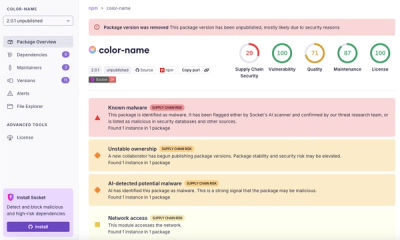
Research
/Security News
npm Author Qix Compromised via Phishing Email in Major Supply Chain Attack
npm author Qix’s account was compromised, with malicious versions of popular packages like chalk-template, color-convert, and strip-ansi published.
@splunkdev/cloud-auth-node
Advanced tools
Splunk Cloud Node Authentication Library for Node.js applications
Splunk Cloud Services Cloud-Auth-Node contains an authentication library for Node.js applications, along with code and examples to enable you to authenticate with Splunk Cloud Services in a Node.js-based application using the JavaScript programming language.
You can use the @splunkdev/cloud-auth-node library alone or with the Splunk Cloud Services SDK for JavaScript to programatically access Splunk Cloud Services.
Splunk Cloud Services Terms of Service
This library supports the following OAuth authorization grant types:
For more about authorization flows that are supported by Splunk Cloud Services, see Plan apps for Splunk Cloud Services on the Splunk Developer Portal.
Install the @splunkdev/cloud-auth-node package to enable your project to authenticate with Splunk Cloud Services.
Run the following command from your project directory if you use Yarn:
yarn add @splunkdev/cloud-auth-node
Run the following command from your project directory if you use npm:
npm install --save @splunkdev/cloud-auth-node
This example demonstrates how to use this library and the Client Credential authorization flow with the Splunk Cloud Services SDK for JavaScript.
require('isomorphic-fetch'); // Or a fetch polyfill of your choosing
const { SplunkCloud } = require('@splunkdev/cloud-sdk');
const { ClientAuthManager, ClientAuthManagerSettings } = require('@splunkdev/cloud-auth-node');
// Initialize AuthManagerSettings
const authSettings = new ClientAuthManagerSettings(
host = SPLUNK_CLOUD_AUTH_HOST,
scope = '',
clientId = CLIENT_CREDENTIAL_ID,
clientSecret = CLIENT_CREDENTIAL_SECRET,
grantType = 'client_credentials',
tenant = TENANT);
// Use AuthManagerSettings to initialize an AuthManager.
const authManager = new ClientAuthManager(authSettings);
// Use AuthManager as the tokenSource to initialize SplunkCloud.
const svc = new SplunkCloud({ tokenSource: authManager, defaultTenant: TENANT });
...
For additional examples, see the examples directory.
For Splunk Cloud Services documentation, see the Splunk Developer Portal.
If you have questions, reach out to us on Slack in the #sdc channel or email us at devinfo@splunk.com.
FAQs
Splunk Cloud Node Authentication Library for Node.js applications
The npm package @splunkdev/cloud-auth-node receives a total of 13 weekly downloads. As such, @splunkdev/cloud-auth-node popularity was classified as not popular.
We found that @splunkdev/cloud-auth-node demonstrated a not healthy version release cadence and project activity because the last version was released a year ago. It has 1 open source maintainer collaborating on the project.
Did you know?

Socket for GitHub automatically highlights issues in each pull request and monitors the health of all your open source dependencies. Discover the contents of your packages and block harmful activity before you install or update your dependencies.

Research
/Security News
npm author Qix’s account was compromised, with malicious versions of popular packages like chalk-template, color-convert, and strip-ansi published.

Research
Four npm packages disguised as cryptographic tools steal developer credentials and send them to attacker-controlled Telegram infrastructure.

Security News
Ruby maintainers from Bundler and rbenv teams are building rv to bring Python uv's speed and unified tooling approach to Ruby development.